This was no ordinary election defeat. This was no ordinary landslide defeat. It is quite possibly the worst defeat of a major party at any state election in modern Australian political history.
When you look at the voting figures, it is terrible, but not unprecedented. Labor’s primary vote of 26.6% is higher than the 25.5% recorded at the 2011 NSW election. Likewise, the two-party-preferred swing will result in a similar 2PP result to the ALP’s defeat in 2011 in New South Wales.
But when you look at the seat-by-seat results, this was devastating. The LNP’s vote was incredibly well distributed, and a primary vote of less than 50% allowed the LNP to win a massive supermajority in the Legislative Assembly.
As of 10:30 Queensland time, the ABC is projecting 78 seats for the LNP, 7 seats for the ALP, 2 seats for Katter’s Australian Party, and two seats for independents.
There are probably a number of reasons for this result. Part of it was caused by the high vote for Katter’s party. Along with winning two seats in far north Queensland, Katter’s party performed very strongly in a large number of seats, and outpolled Labor in many seats.
An immediate cause is Queensland’s electoral system. Optional preferential voting, single-member districts and a lack of ultra-safe Labor seats meant that a large LNP victory almost wiped out the Labor caucus.
This reminds me of a number of Canadian elections, including the 1993 federal election, when the governing Progressive Conservative party was reduced to only two seats. At the 2001 British Columbian provincial election, the governing New Democratic Party was wiped out, only holding two seats compared to 77 seats for the Liberal Party.
We don’t usually see these results in Australia, but there’s nothing about our electoral system that stops them. It’s possible for a single-member result to produce an overwhelmingly lopsided result which doesn’t reflect the votes. While we rarely get a result that proportionally reflects our vote, the result is usually diverse enough for both parties to remain viable. Both parties usually have a solid core of safe seats that sustain them in hard times.
In contrast, Labor is going to have an extremely tough time now. With only 7 MPs, they will be completely unable to serve as an effective opposition, and will have very few resources to keep the Newman government in check. It raises interesting questions about the need for proportional representation, but I will blog about that later.
I plan on writing a second blog post focusing on the pattern of results, but here I want to focus on the general trends.
First of all, as I said earlier, this is no ordinary Labor defeat. This is a severe defeat that will make it difficult for Labor to compete in Queensland in the coming years and will likely make life harder for Labor in Queensland at next year’s federal election.
As for the reasons, I normally shy away from mixing federal and state political issues, but I can’t imagine that the state of Labor federally didn’t play a role. Whether it is the Gillard vs Rudd feuding, the carbon tax or the hung parliament, Labor’s difficulties federally surely made life harder for Bligh and increased the walloping she suffered tonight. Suddenly it’s not so hard to imagine Labor getting all but wiped out in Queensland at the next federal election.
On a broader scale, I would argue that Labor’s collapse, both in NSW and Queensland, is in part the consequence of the ongoing crisis of identity that has racked the ALP, and this crisis of identity could see the federal ALP suffer a similar defeat in 2013. Greens preferences won’t save the ALP from itself – at some point the party needs to work out what it is about, and give people a positive reason to vote for them. Otherwise defeats like that seen in Queensland will be repeated across Australia.
It was clearly a brilliant result for the Liberal National Party, but I think it does indicate that, regardless of the details, the conservative side of politics was headed for a big win. I can’t imagine that the LNP wouldn’t have been able to win without Campbell Newman. Indeed I can’t see how Labor could have beaten an unmerged National-Liberal coalition, although they may have held on to a few more Brisbane seats.
It was an impressive result for Katter’s party. It is difficult for any minor party to win single-member seats, and they won two of them. They also won large proportions of the vote in quite a few electorates.
For the Greens, I think it was a decent result in a hard election. I’m certainly not going to claim it was a fantastic result. Overall the Greens vote went backwards and they didn’t manage to come in the top two in any of those inner-city seats where the Greens have tried to challenge the major parties. Interestingly the Greens came second in Noosa.
As I said after the election in New South Wales, I don’t believe that these kinds of elections are fertile ground for the Greens. The Greens’ big result in the federal election was in the opposite climate: where people are less focused on changing government and open to alternatives. Usually in elections like this one in Queensland people go straight to the major party headed for government.
After the New South Wales election, there was a lot of criticism, both internally and externally, blaming the NSW Greens’ structure, public image and ideological direction for the failure to win Marrickville and the relatively small swing gained. The Queensland Greens ran a very different campaign and work very differently to the Greens NSW, yet similarly were unable to turn a massive defeat for the ALP to their benefit. I think this suggests that greater forces are at play. This isn’t to downplay the importance of all parties being self-reflexive. It’s just important to understand that external factors can play a big role in electoral fates, particularly for a minor party.
Tomorrow I plan on posting some more information on the geographical breakdown, as well as some thoughts on what this lopsided result says about our electoral system. For now, here are some maps.
The following maps show South-East Queensland and Far North Queensland at the 2001, 2009 and 2012 elections. Red represents Labor, blue represents Liberal/Liberal National, light green represents National, light blue represents seats won by the LNP at the 2012 election, and purple represents One Nation in 2001, and Katter’s Australian Party in 2012.
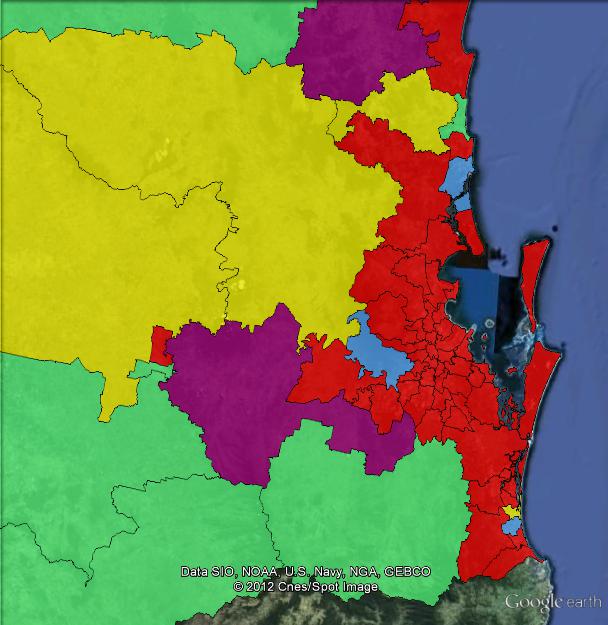
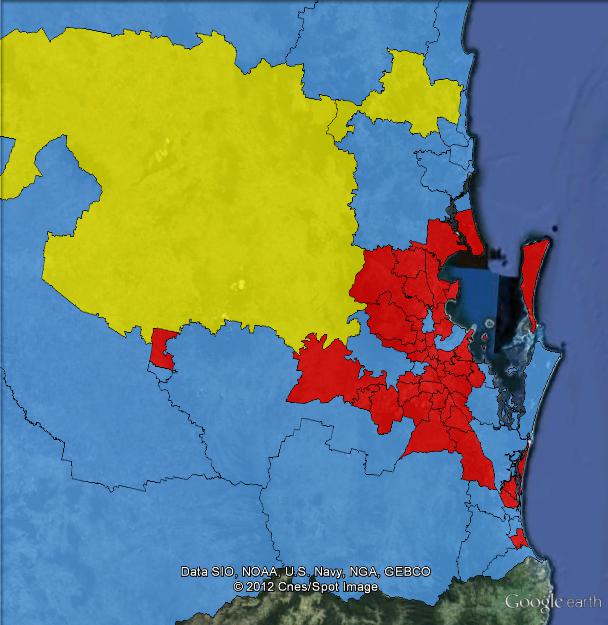
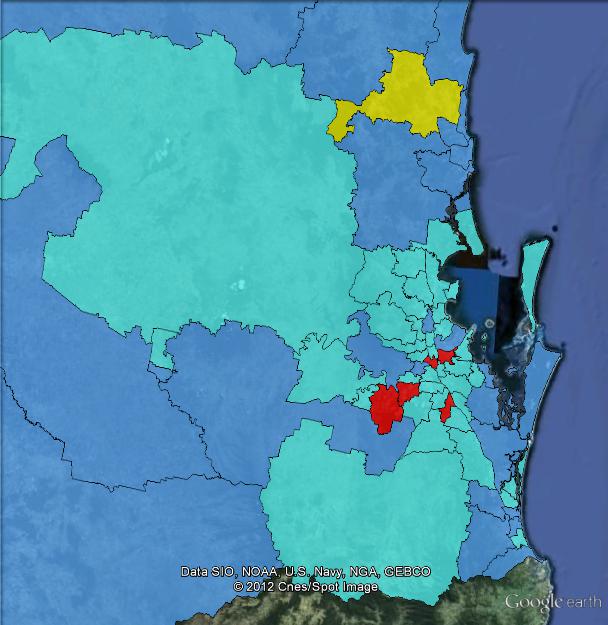
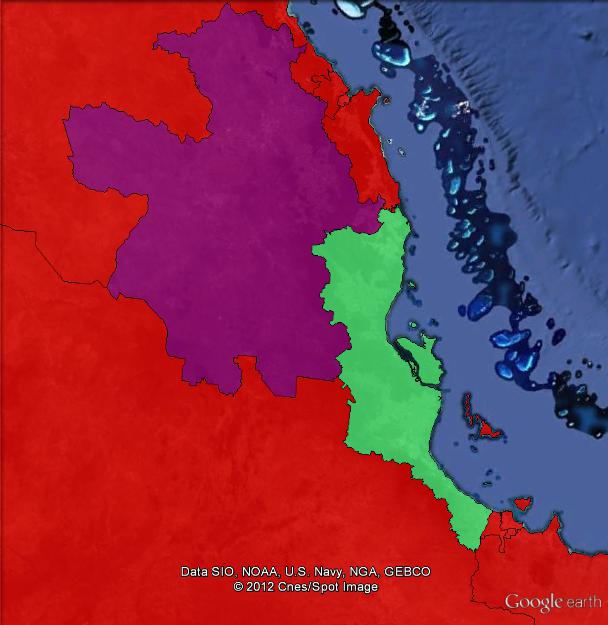
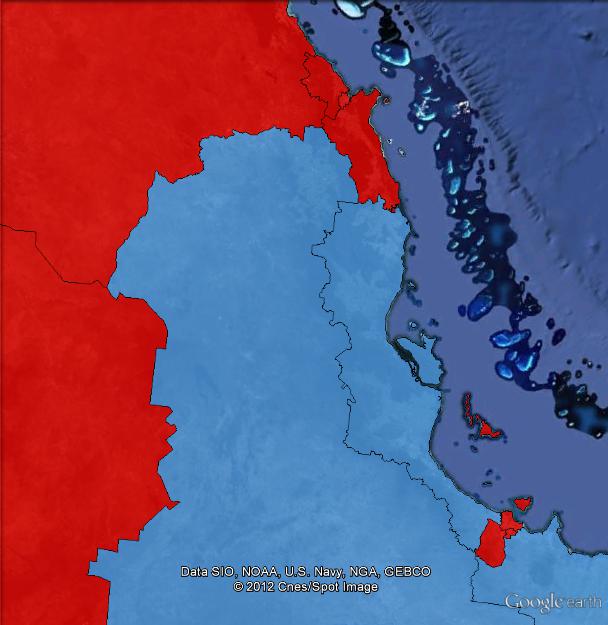
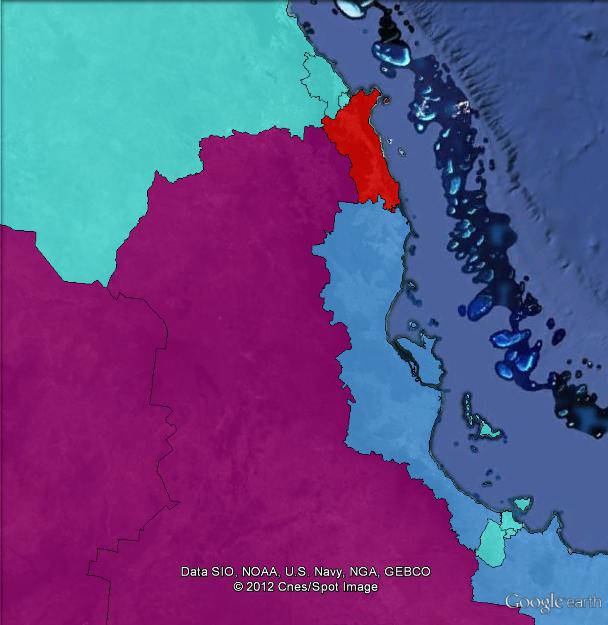



Am I the only one concerned progressive politics is going to die in Australia if these crazy super landslides like in NSW, now QSL, and soon federally arnt stopped?
The lack of a proportional upper house will make a big difference when compared with NSW where OFarrell has had to moderate his agenda to work with CDP/Shooters.
Would a bicameral parliament in Qld be enough? PR in the House seems pretty unlikely in any jurisdiction, unfortunately.
The LNP’s victory makes the Lib/Nats victory in NSW look modest in comparison. How could pollsters underestimate that massive swing against Labor? I don’t think I was the only surprised when the ABC was saying there was a 15% swing against Labor when all the polls were saying Labor was only facing a 10% swing.
A sad event for democracy and yes, proportional representation is needed! About time Labor pushed for proportional representation because it is in their best interests.Not having an Upper House in Queensland is a shocking thing. At least in NSW there are checks and balances with the Legislative Council. Thank goodness for the Australian Senate.The LNP in Queensland will be able to do anything that they like but the ‘foreign’ controlled media will spend the next 4 years talking about how weak the Labor Opposition are and not bringing The LNP to account.
aww Brenty.. its no different to the years of slagging against the coalition, where a decent charismatic leader did not emerge until Campbell Newman.
Point is, the people voted, and they voted for what they DIDN’T want – and that was another term in government for the ALP, of thinking surely this can’t get any worse, only to be eating their words, next time an illuminated decision to trash us further was pulled out of their collective asses.
This reminds me of the mess John Howard and his government had to clean up after the Whitlam/ Hawke / Keating years, and , make no mistake, Campbell is going to be hated for the recovery he has to micromanage. BUT , at least he’ll do the job properly.
A sad day for Democracy? This IS democracy!
Come on, Brenty. This is no sad day for democracy. It’s true that Labor has been decimated, but if Newman isn’t careful, he might find his majority slashed come the next election. It’s also true that for the last two decades or so, people have voted more along the lines of what they didn’t want rather than what they wanted, and right now they don’t want Labor in QLD.
As for proportional representation and minor parties, the call for them really stems from a failure of leadership from the major parties. Leaders seem to have lost the ability to make unpopular decisions that happen to be for the greater public good, and tell voters a believable story that convinces them to stick with the leader through tough times, in the hope of coming good at the end. Kennett did it to some extent in Victoria – after making hard decisions, he insisted that they had to be made but he convinced Victorians that he’d see them through the pain and that they’d bear fruit within a few years, and by the next election the hard decisions seemed to have borne enough fruit to convince (most) voters to give Kennett another go. This sort of leadership seems hard to come by nowadays, and this is why people have been increasingly throwing their lot in with minor parties and Independents.
There’s no reason why the Greens, or other minor parties, can’t win a seat in the QLD Parliament. But perhaps they should focus on seats where their vote is strong and ignore lots of other seats so that they can put their resources in winning those strong seats. Bob Katter, for instance, seems to have more delusions of grandeur than I can keep track of, but his mob had enough concentrated support to win a few seats, despite losing a seat as well. All isn’t lost for minor parties.
The obvious problem for the Greens in Queensland is that all their good seats are also good for the LNP. The LNP vote is way too high in the inner city seats for the Greens to overtake them and finish second.
In fact, the LNP actually won all the good Green seats in Brisbane apart from South Brisbane. You’d need a wipeout worse than 2001 for the LNP to fall to third.
I certainly agree that an Upper House is needed in Queensland. For quite a while now i have wondered why the LNP (and previously the coalition), even bothered debating against bills that would simply be rammed straight through into legislation. Labor will now face the same problem.
Of course the Leg. Council was dissolved by Labor becuase they viewed it as tool of the upper class. Even as a conservative I don’t deny this was true. However, they could have just eased from the previous system into proportional representation, just like all the other states. This would have rendered Joh’s gerrymandering not nearly as effective and would give Labor much more representation than they have at this time. In a way, they only have themselves to blame.
I recall Qld had an appointed upper house, thus its dissolution was seen as a victory for Labor against the establishment at the time.
Why do third world dictators worry about rolling up 90% of the vote in favour of dodgy regimes? In Australia we can show you how to get nearly 90% of the seats with about 51% of the vote.
Seriously though this is not good for governance and accountability in government.
I would predict though that some people got elected for the LNP that even the head office did not anticipate would be returned and we can look forward to probably a couple of resignations during the first 12 months by MPs who are just not up to scratch and don’t understand what conflict of interest is.
We can also anticipate a backbench that will have too little to do and will be hard to keep on the reservation once they realise that they have not got a ministry, will never get a ministry and probably are not going to be re-elected. The effects of this might take a bit longer to work through the system.
Doug makes a good point. However, as many Labor members had been union officials, lobbyists or public servants, they had not much in the way of private business interests. This makes them a very small target for that kind of criticism. This is why they can dish out accusations like Fraser’s “brother-in-law was in the same rugby team” tirade, and is also why they came down so hard on Gordon Nuttall. For christ’s sake, the guys second charge was literally pulled out of a hat a few months before the end of his sentence. On that occassion, he was also fined for negligence that could only have occured if he was NOT guilty. In short, what I am trying to say is that people who lack integrity are overly skeptical of good people, and just plain mean to fallguys like Nuttall.
Doug, as Jeff Seeney pointed out on ABC last night: it’s a problem, but a good problem to have!
Don’t expect any push for proportional representation from Labor. They were perfectly happy to use this electoral system to rack up massive landslides in their own favour in the 2000’s. I’m sure they know perfectly well how hypocritical and silly they would look to only start sooking about it when the boot’s on the other foot.
To those who live in Queensland:
How would the 2009 and 2012 elections turned out if Peter Beattie continued as Premier?
“ Interestingly the Greens came second in Noosa”
not so surprising at all… Noosa has a similar demographic to NSW’s Balmain, where “we” Greens now have a lower house seat. Balmain is affluent, very Anglo, tertiary educated and one of the most privileged parts of Sydney.
Another thing: Probably few here on this site take anything Barnaby Joyce says seriously, though one observation of his this morning has some resonance: “If you want the know what it looks like when you have Greens preferences stitched up, “ he said on RN, “come to Queensland.
Colourful as ever, sure… but Labor should take note. I can’t think of any other reason for Bligh’s deeply flawed Wild Rivers plan (now gone thankfully), which would have locked some of the most disadvantaged members of our community out of an economic stake in their own land, other than for the preferences of some of the richest people in the country.
But the Greens vote declined all round in inner Brisbane, spectacularly so in Indoroopilly.
One last observation: “I don’t believe that these kinds of elections are fertile ground for the Greens and our type of politics,’ says Ben. The next Fed one will be one of “these kinds of elections.”
Comments are closed.